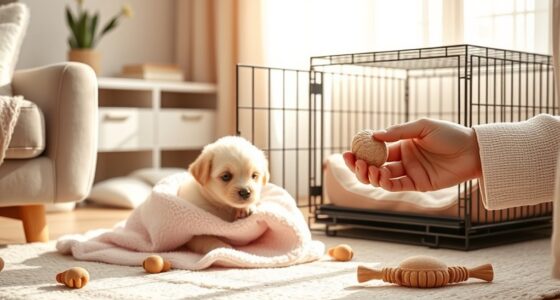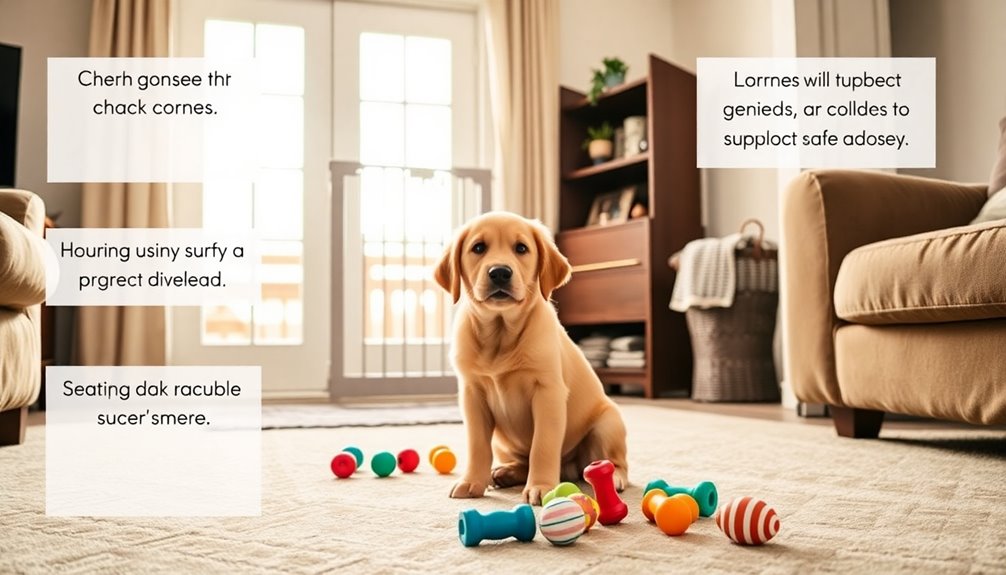Choosing between crate training and free roaming depends on your puppy’s needs and your lifestyle. Crate training offers a structured, safe space that makes house training easier and helps prevent destructive behaviors, especially with consistent positive reinforcement. Free roaming promotes independence but requires strict routines and supervision to avoid accidents and damage. To find the best approach for your puppy’s behavior and well-being, consider the benefits and challenges of each—there’s more to learn to make the right choice.
Key Takeaways
- Crate training aids housebreaking by teaching puppies boundaries and helping them learn to hold their bladder longer.
- Free roaming encourages independence but requires strict routines and supervision to prevent accidents and destructive behaviors.
- Consistency and positive reinforcement are essential in both methods to ensure effective training and a safe environment.
- Crate training provides a safe, structured space, while free roaming promotes relaxation and independence with proper rules.
- Choose based on your puppy’s temperament, your schedule, and your ability to supervise, balancing safety and comfort.

Are you unsure whether to crate train your puppy or let them roam freely around the house? Deciding between these options can feel overwhelming, but understanding how each approach impacts house training and crate etiquette can help you make the best choice for your pup. Crate training is often seen as the more structured method, providing a safe space that facilitates house training. When you introduce your puppy to a crate, you’re fundamentally teaching them that certain areas are off-limits, which helps reduce accidents inside the house. Proper crate etiquette involves making the crate a positive environment—never using it as punishment—and gradually increasing your puppy’s comfort level with being inside. If you start early and use positive reinforcement, your puppy will associate the crate with safety and comfort, making house training smoother. They learn to hold their bladder longer because they don’t want to be confined in the crate for too long, which accelerates the process of housebreaking. On the other hand, letting your puppy roam freely might seem appealing, especially if you want a more relaxed environment. However, unrestricted freedom can complicate house training, as your puppy may not understand what areas are off-limits. Without clear boundaries, accidents can happen more often, and your puppy might develop bad habits that are harder to correct later. If you choose free roaming, you’ll need to establish consistent routines and supervise closely to prevent messes and destructive behaviors. This approach requires more hands-on management and patience but can foster a more independent puppy. Still, it’s essential to set clear house rules and boundaries from the start. For example, designate certain rooms or areas as off-limits, use baby gates, and reward good behavior. Whether you opt for crate training or free roaming, consistency is key. If you decide on crate training, ensure your puppy’s crate is appropriately sized—large enough to stand, turn around, and lie down comfortably—and never leave them in the crate for too long. If you prefer free roaming, establish a schedule for bathroom breaks and playtime, and keep a close eye on their activities. Remember, the goal is to create a safe, comfortable environment that encourages good habits. Additionally, incorporating training techniques can significantly improve the effectiveness of either method. Whichever method you choose, patience and positive reinforcement are vital. With consistent training, your puppy will learn what’s expected, easing the transition into a well-behaved, happy member of your household.
Frequently Asked Questions
How Long Should I Crate Train My Puppy Each Day?
You should crate train your puppy for about 1 to 3 hours at a time, gradually increasing the duration as they get comfortable. Keep crate duration appropriate to their age and guarantee training consistency. Short, frequent sessions help your puppy build positive associations with the crate. Remember to always end on a positive note and avoid leaving your puppy in the crate for too long, which can cause stress or anxiety.
Can Free Roaming Cause My Puppy to Develop Bad Habits?
Free roaming can turn your home into a wild jungle if you’re not careful. It might lead to bad habits like chewing, jumping, or bathroom accidents without proper housebreaking consistency. To prevent this, set clear boundaries and offer ample socialization opportunities, guiding your puppy like a steady captain steering a ship. With consistent rules and positive reinforcement, you help your pup learn good behavior, transforming free roaming into a safe, enjoyable adventure.
Is It Okay to Switch Between Crate Training and Free Roaming?
Yes, it’s okay to switch between crate training and free roaming, but you should do so gradually. Using alternative methods helps your puppy adapt comfortably. Maintain training consistency to reinforce good behavior, ensuring your puppy understands boundaries and expectations. Switching too quickly can confuse your pup, so introduce changes slowly and positively. This approach helps your puppy feel secure and builds a balanced routine, promoting healthy development and behavior.
How Do I Prevent My Puppy From Feeling Isolated in the Crate?
Your puppy’s crate should feel like a cozy den, not a lonely cage. To prevent feelings of isolation, provide puppy companionship through gentle presence and positive interactions nearby. Make the crate comfortable with soft bedding, toys, and familiar scents. Spend time with your pup outside the crate, gradually increasing crate time to build trust. This helps your puppy associate the crate with safety, comfort, and love, easing feelings of loneliness.
What Are the Signs My Puppy Prefers One Method Over the Other?
You can tell your puppy prefers one method over the other by observing their body language and crate comfort. If your puppy relaxes, happily enters the crate, and shows no signs of stress, they likely favor it. Conversely, if they’re anxious, try to escape, or seem uncomfortable, they might prefer free roaming. Pay attention to their tail wagging, relaxed posture, or signs of distress to gauge their preferences.
Conclusion
Ultimately, whether you choose crate training or free roaming, remember it’s about understanding your puppy’s needs. Think of it like planting a garden: some plants thrive in a cozy, protected space, while others flourish when given room to explore. I once watched my puppy find comfort in her crate during thunderstorms, like a seed nestled safely in soil. Trust your instincts, and you’ll help your puppy grow into a confident, happy dog.










